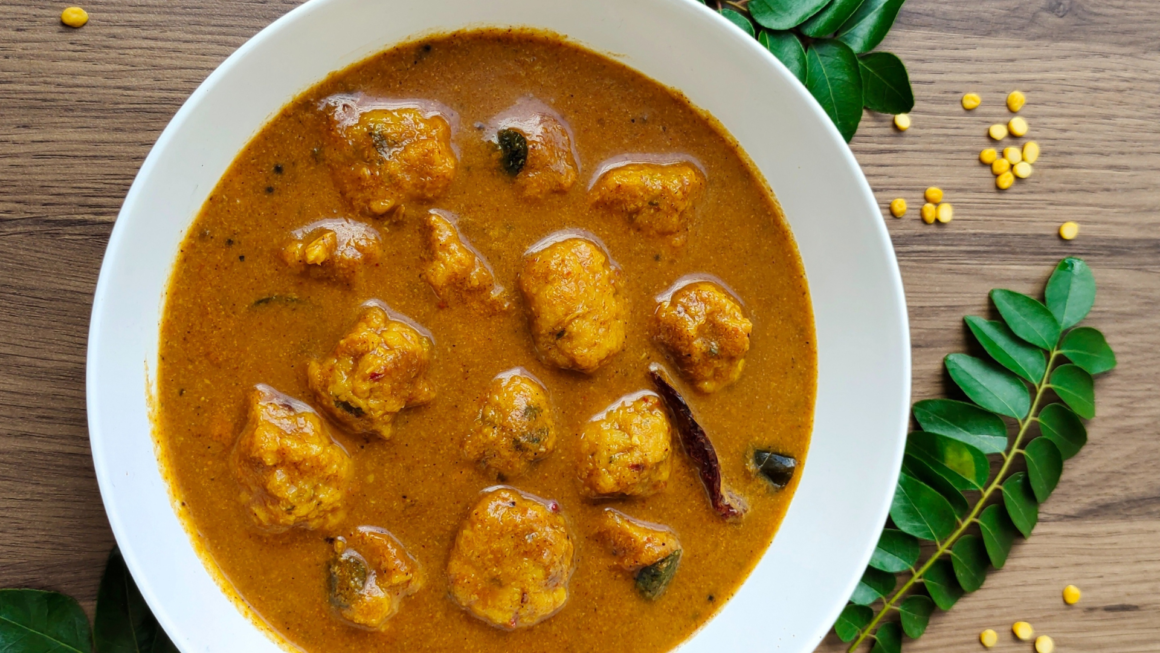Paruppu Urundai Kozhambu is a traditional Tamil dish, where lentil balls are simmered in a spiced tamarind gravy. After soaking and grinding the lentils, they are steamed and then incorporated into a rich tamarind-infused sauce. This dish delivers a harmonious blend of sweet, sour, and spicy flavours. Best served with rice and a drizzle of sesame oil, it beautifully complements other dishes like poriyal and paruppu usili.
I hold fond memories of those summer holidays spent with my cousins, all of us eagerly waiting for our grandmother’s special preparation of Paruppu Urundai Kozhambu. We would sit with our hands held out and grandma would place morsels of rice mixed with this kozhambu on our palms. Little did I know that those simple meals, enjoyed in the company of family, would become unforgettable feasts that I would treasure forever.
In my attempt to preserve these traditions, I have chronicled recipes like this one on my blog. I’ve shared the Paruppu Urundai Kozhambu just as my grandmother used to make it. To my delight, many of my readers have reached out, saying that it brought back flavours from their own grandmothers’ kitchens. It’s a testament to the timeless allure of such recipes. Through food, I believe, we find beautiful connections to our past.
Paruppu Urundai Kozhambu
Ingredients
- Chana dal: ½ cup
- Dry red chillies: 3 (+2 more for tempering)
- Tamarind: Lemon-sized ball
- Finely chopped coriander: 1 tbsp
- Salt to taste
- Sesame oil: 1 tbsp (+ extra for drizzling)
- mustard seeds: ¾ tsp
- Fenugreek seeds: 1⁄8 tsp
- Curry leaves: 1 sprig
- Asafoetida (hing): 2 pinches
- Turmeric powder: ½ tsp
- Sambar powder: 1 tbsp (adjust to taste)
- Red chilli powder: 1 tbsp (optional, adjust to taste)
- Jaggery powder: : 1 tbsp (adjust to taste)
- Fresh coconut: 2 tbsp
Method:
- Rinse chana dal and soak along with 3 dry red chillies for 2 hours, ensuring they’re submerged.
- Soften tamarind by soaking it in boiling water.
- After soaking, drain chana dal and red chillies. Coarsely grind them without water.
- Transfer this mixture to a bowl, season with salt, and mix in chopped coriander.
- Steam small balls made from the lentil mixture for about 12 minutes.
- Once the tamarind is cool, extract its juice, strain, and set aside.
- Grind the coconut into a slightly coarse paste with a bit of water.
- Heat sesame oil in a pan. Add mustard seeds, followed by asafoetida, fenugreek, curry leaves, and 2 red chillies.
- Pour in the tamarind juice, seasoning with salt and turmeric. Cook until the raw aroma fades (around 4-5 minutes).
- Add water for desired consistency.
- Incorporate sambar powder, red chilli powder (if using), and jaggery.
- Gently place the steamed lentil balls into the pan.
- After 7-8 minutes, or when the balls float, stir in the coconut paste.
- Cook for an additional minute, ensuring constant stirring. If the consistency is a bit thin, don’t worry, it’ll thicken over time. Finish with a drizzle of sesame oil and serve warm with rice.
Tips
- Adjust water for the sauce’s thickness and sourness. It starts watery and thickens over time.
- The chana dal should be ground coarsely for best texture.
- For authenticity, use sesame oil (‘nalla ennai’ in Tamil), distinct from toasted sesame oil.
- Omit red chilli powder if your sambar powder is spicy.
- While jaggery enhances flavour, adjust or omit as per preference. You can also use traditional jaggery blocks.
- After adding coconut paste, avoid overcooking and ensure continuous stirring, so it doesn’t split.
Watch this recipe here – Paruppu Urundai Kozhambu

Priya Iyer is a food and travel writer, recipe developer, home chef, avid book reader and doting mommy, based in Bangalore. She started blogging in 2007 as a way of sharing her food and travel experiences with the world. Her stories include records of her family’s recipes, treasured regional foods from Tamilnadu, other foodie adventures and travel tales. She started retailing pickles, jams, and spice mixes from her kitchen in 2020, as a means to make good-quality, additive-free food more accessible.
Translations and detailed descriptions are provided to give a better understanding of the story to people from different cultural backgrounds across the globe.

